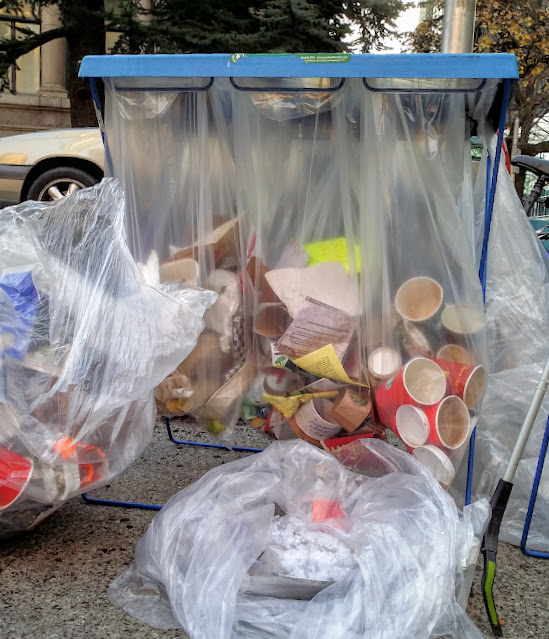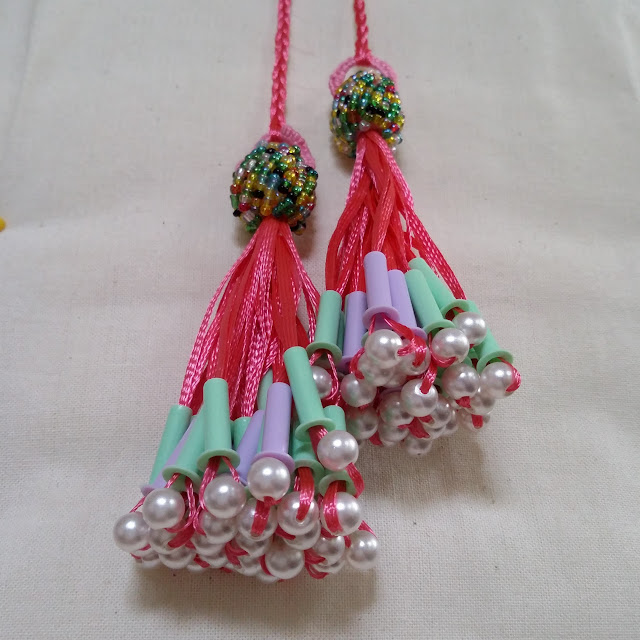Today I attended my first demonstration - I was part of a small group of volunteers from the Master Recycling program tasked with handling the waste needs of the Global Climate March, taking place on the grounds of the Vancouver Art Gallery. I would receive 3 hours credit toward 30 hours community outreach needed to complete the course. My job: overseeing a recycling station - directing unwanted items into one of three categories: organics, paper, containers.
 |
| Five thousand in support of the Earth on a cold, sunny day |
I arrived just before 1PM, as the upbeat, bundled-up crowd was beginning to gather. There were hundreds of banners and placards with catchy, pro-environment slogans, groups of enthusiastic people in home-made costumes: kooky green getups covered with leaves, or over-sized, ominous grim reapers. Others wore masks, wigs, capes, crinolines, face paint. A group of people held aloft 50 cardboard salmon on sticks. I saw a small child with red hair carrying a sign: Gingers for Climate Change.
The atmosphere was hopeful, optimistic, friendly. Drummers and singers performed on the gallery steps, others waited their turn, danced, smiled, milled about, warming themselves with coffee, hot chocolate, tea. Serious business, but fun - the square was crowded with well-informed people, ready for change.
 |
| Concerns, enthusiasm |
Soon, the recycling equipment arrived, towed behind the bicycle of one of the recycling course facilitators: a few blue, metal frames, a box of plastic bags, some work gloves and garbage pickers.
We set up 3 stations, spaced strategically around the perimeter - in the line of foot traffic, but just barely. Soon enough the bags began to fill.
Here is what I learned:
 |
| Organics, paper, containers. Masses of white fluff bound for the landfill. Note the garbage picker - this kind does not work well! |
Recycling Protocols are Confusing
Despite the pictures and words on the lid of the bins, explaining what goes where, people were confused. Wanting to do the right thing, but not being certain how, folks deliberated before committing their waste. Coffee cups: with the organics or containers or paper?*What about plastic cutlery? A man showed me the triangle arrows symbol** on the back of his spoon. "It must be recyclable," he told me, "It should go with the plastic containers." The woman in the nearby food vendor truck confirmed my hope that the cutlery was compostable. Ah... the organics slot. Who knew?
The bags continued to fill.
*FYI, today, coffee cups were to go with the plastic, metal or glass containers, along with their plastic lids, removed. Technically recyclable, Vancouver's blue boxes accept coffee cups. However, it is cheaper to make a new cup than to separate the thin plastic liner from the paper to recycle it, so you might wonder what actually happens to it
**The triangle arrows symbol indicates the type of plastic the item is made of, NOT that it is necessarily recyclable
Not Everybody will Take the Time to Work Out What Goes Where
Those who did not hesitate generally chose the wrong slot for their waste: napkins in the paper recycling, instead of with organics. Paper sleeves from take-out cups thrown along with the cup into the containers section, instead of being removed and added to the paper. People thinking they were doing the right thing, but not finding out for sure. |
| Cleaning up while the crowd marches for the climate Cups, paper, bits of costume, cigarettes, plastic |
Some People Litter
As the crowd began to march, our small group prepared to follow along, tidying up as we went. Garbage bags and pickers in hand, we would leave the streets spotless. I stayed behind, picking up debris from the frozen Art Gallery grounds. The amount of trash I found scattered about surprised me.As I worked, I was approached by the building's custodian, who confirmed the trash I was picking up was solely a result of the demonstration, as he had cleaned it just the day before. I had expected folks so passionate about the climate wouldn't litter, but I found coffee cups, paper flyers, banana and orange peels, apple cores, cigarette butts and packaging, many abandoned placards, and clump after clump of white, curly, polyester? fluff, fallen from various protestors' costumes. It was everywhere.
 |
| Sorting the waste |
A chilly hour later, the crowd - now less than half the size - returned. Speeches and music continued while we six sorted and amalgamated bags of waste. The biggest collection: coffee cups, by far; followed by organic waste from lunches and snacks; then paper waste - bus tickets, cigarette packages, leaflets, newspapers and free magazines: The Georgia Straight, 24 hrs, Metro. Warning inserts from many, many cigarette packs. There was one bag of landfill-destined debris containing straws, candy wrappers, paper too dirty to recycle, an acrylic toque. I was amazed when I saw it all gathered up: just how much paper and plastic was discarded in the course of less than three hours!
 |
| Beautiful message; what about the medium? |
Sorting done, the bags were divided up to be transported by the volunteers to the appropriate destination: recycling or composting facility, landfill. The organizers, who have managed the recycling at many events before this one, seemed satisfied at the dwindling amount of waste produced, compared to past events - it could all be carried away by hand or bicycle.
We said good-bye, and I went home to warm up and think about the day, my first demonstration. I'm encouraged to know the trash situation is improving overall, and excited to be a part of a larger movement toward a healthier, more sustainable Earth, but my impression from the day is that there is much change still to be made on a smaller, personal scale. I am left wondering what more I can do to effect change in myself and the caring, engaged people around me. I will start with something small...
 |
What can we change about our habits that will impact the climate?
Carry a drink cup? Refuse a straw or a plastic bag? Quit smoking?
Even small changes make a difference
|











